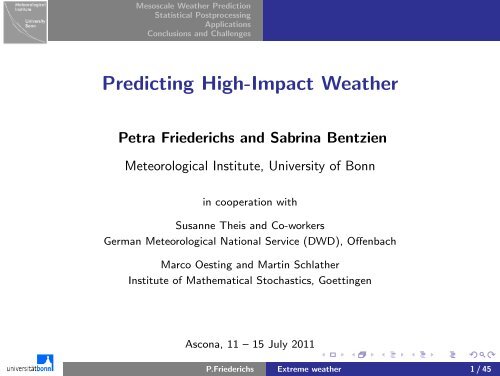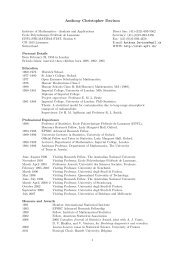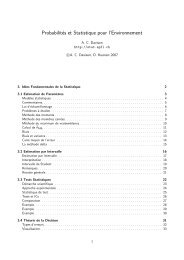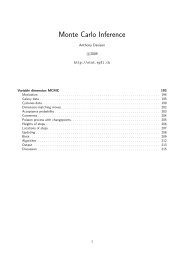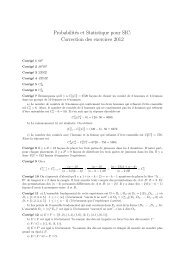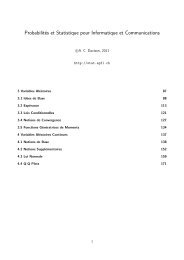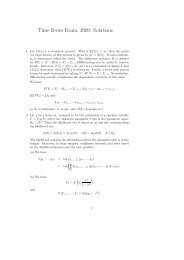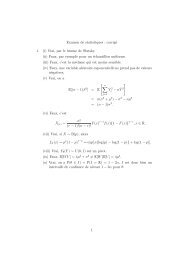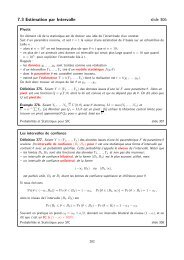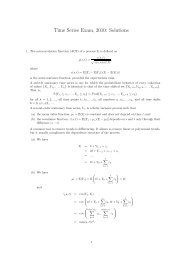Petra Friederichs - Chair of Statistics STAT
Petra Friederichs - Chair of Statistics STAT
Petra Friederichs - Chair of Statistics STAT
You also want an ePaper? Increase the reach of your titles
YUMPU automatically turns print PDFs into web optimized ePapers that Google loves.
Mesoscale Weather Prediction<br />
Statistical Postprocessing<br />
Applications<br />
Conclusions and Challenges<br />
Predicting High-Impact Weather<br />
<strong>Petra</strong> <strong>Friederichs</strong> and Sabrina Bentzien<br />
Meteorological Institute, University <strong>of</strong> Bonn<br />
in cooperation with<br />
Susanne Theis and Co-workers<br />
German Meteorological National Service (DWD), Offenbach<br />
Marco Oesting and Martin Schlather<br />
Institute <strong>of</strong> Mathematical Stochastics, Goettingen<br />
Ascona, 11 – 15 July 2011<br />
P.<strong>Friederichs</strong> Extreme weather 1 / 45
Mesoscale Weather Prediction<br />
Statistical Postprocessing<br />
Applications<br />
Conclusions and Challenges<br />
Why high-impact weather<br />
◮ Mathematically:<br />
Defined as block maxima or excedances <strong>of</strong> large thresholds.<br />
Events that lie in the tails <strong>of</strong> a distribution<br />
◮ Perseption:<br />
Rare, exceptional, ”large” and high impact<br />
◮ Problems:<br />
◮<br />
◮<br />
95% quantile <strong>of</strong> daily precipitation: ≈ 10 − 15mm/d<br />
≈ 2-5 years <strong>of</strong> data – only few extremes events for verification<br />
P.<strong>Friederichs</strong> Extreme weather 2 / 45
Mesoscale Weather Prediction<br />
Statistical Postprocessing<br />
Applications<br />
Conclusions and Challenges<br />
Outline<br />
Predicting High-Impact Weather<br />
◮ Atmospheric scales and mesoscale atmospheric dynamics<br />
◮ Numerical weather prediction<br />
◮ Forecast uncertainty and ensemble prediction systems<br />
Ensemble postprocessing<br />
◮ Postprocessing: Extract and calibrate information<br />
Application<br />
◮ Ensemble postprocessing – precipitation<br />
◮ Spatial modelling – wind gusts<br />
P.<strong>Friederichs</strong> Extreme weather 3 / 45
Mesoscale Weather Prediction<br />
Statistical Postprocessing<br />
Applications<br />
Conclusions and Challenges<br />
Mesoscale Extremes<br />
Predicting high-impact weather<br />
Ensemble Postprocessing<br />
Mesoscale Weather Prediction<br />
◮ Strong and disastrous impact <strong>of</strong> many weather extremes calls<br />
for reliable forecasts<br />
◮ ”Although forecasters have traditionally viewed weather<br />
prediction as deterministic, a cultural change towards<br />
probabilistic forecasting is in progress.” (T N Palmer, 2002)<br />
◮ Weather extremes do not come ”Out <strong>of</strong> the Blue”<br />
◮ Numerical weather forecast models provide reliable forecasts<br />
<strong>of</strong> the atmospheric circulation prone to generate extremes<br />
◮ Combination <strong>of</strong> dynamical and statistical analysis methods<br />
P.<strong>Friederichs</strong> Extreme weather 4 / 45
Mesoscale Weather Prediction<br />
Statistical Postprocessing<br />
Applications<br />
Conclusions and Challenges<br />
Mesoscale Extremes<br />
Predicting high-impact weather<br />
Ensemble Postprocessing<br />
Atmospheric scales and mesoscale dynamics<br />
◮ Different scales exhibit different<br />
dominant force balances,<br />
different wave dynamics<br />
◮ Mesoscale on horizontal scales<br />
2km – 2000km<br />
◮ Complex force balances<br />
Steinhorst, Promet 35, 2010<br />
P.<strong>Friederichs</strong> Extreme weather 5 / 45
Mesoscale Weather Prediction<br />
Statistical Postprocessing<br />
Applications<br />
Conclusions and Challenges<br />
Mesoscale Extremes<br />
Predicting high-impact weather<br />
Ensemble Postprocessing<br />
Mesoscale extremes<br />
Squall-line 14 July 2010<br />
1000<br />
998<br />
A. Kelbch (2010)<br />
35<br />
30<br />
996<br />
25<br />
994<br />
20<br />
Gartenstation MIUB<br />
6 9 12 15 18 21 24<br />
July 2010<br />
P.<strong>Friederichs</strong> Extreme weather 6 / 45
Mesoscale Weather Prediction<br />
Statistical Postprocessing<br />
Applications<br />
Conclusions and Challenges<br />
Mesoscale Extremes<br />
Predicting high-impact weather<br />
Ensemble Postprocessing<br />
High-impact weather<br />
◮ European mid-latitudes:<br />
Heavy rain and/or violent wind, lightning, hail, . . .<br />
◮ Deep midlatitude convection – Warm season heavy<br />
precipitation clusters<br />
◮ Processes with time scale <strong>of</strong> ∼1h - 1d<br />
◮ Convective cells – organized and embedded within larger<br />
weather systems – initiated on much smaller scales<br />
www.dwd.de<br />
◮ THORPEX - European Section<br />
P.<strong>Friederichs</strong> Extreme weather 7 / 45
Mesoscale Weather Prediction<br />
Statistical Postprocessing<br />
Applications<br />
Conclusions and Challenges<br />
Mesoscale Extremes<br />
Predicting high-impact weather<br />
Ensemble Postprocessing<br />
Predictability<br />
◮ Inherent limit <strong>of</strong> predictability<br />
◮ Fastes error growth at smallest<br />
scales<br />
◮ Predictability strongly depends<br />
on flow regime<br />
◮ Moist convection is primary<br />
source <strong>of</strong> forecast-error growth<br />
◮ Mesoscale forecasts are issued<br />
for ≤18h-24h<br />
E N Lorenz, Tellus 21, 19 (1969)<br />
P.<strong>Friederichs</strong> Extreme weather 8 / 45
Mesoscale Weather Prediction<br />
Statistical Postprocessing<br />
Applications<br />
Conclusions and Challenges<br />
Mesoscale Extremes<br />
Predicting high-impact weather<br />
Ensemble Postprocessing<br />
COSMO-DE Ensemble Prediction System (EPS)<br />
◮ 2.8 km grid spacing – convection<br />
permitting NWP model<br />
◮ Operational forecasts 0-21 hours (DWD)<br />
◮ EPS with 20 (40) members since 12/10<br />
◮ Uncertainty due to<br />
Initial conditions<br />
Boundary conditions<br />
Model parameterization<br />
◮ High-impact weather<br />
Postprocessing is an integral part <strong>of</strong> an EPS<br />
GME<br />
COSMO-DE<br />
COSMO-EU<br />
Initial State Boundary Model<br />
Theis, DWD (2010)<br />
P.<strong>Friederichs</strong> Extreme weather 9 / 45
Mesoscale Weather Prediction<br />
Statistical Postprocessing<br />
Applications<br />
Conclusions and Challenges<br />
Mesoscale Extremes<br />
Predicting high-impact weather<br />
Ensemble Postprocessing<br />
E (κ) [m 3 s 2 ]<br />
1e−02 1e+01 1e+04 1e+07<br />
λ [km]<br />
628 314 125 62 31 12 6<br />
(−5 3)<br />
κ<br />
1e−05 5e−05 2e−04 5e−04<br />
κ [rad/m]<br />
Bierdel, Bentzien, <strong>Friederichs</strong> (2011)<br />
κ −1.55 21.08.2009<br />
COSMO-DE-EPS<br />
(Experiment 2009, 20 members)<br />
◮ Forecast hour 10<br />
◮ Mesoscale k −5/3 spectrum<br />
◮ No spin-up effect<br />
◮ Effective resolution:<br />
4 to 5 · ∆x<br />
P.<strong>Friederichs</strong> Extreme weather 10 / 45
Mesoscale Weather Prediction<br />
Statistical Postprocessing<br />
Applications<br />
Conclusions and Challenges<br />
Mesoscale Extremes<br />
Predicting high-impact weather<br />
Ensemble Postprocessing<br />
Ensemble Postprocessing<br />
◮ COSMO-DE forecasts 1 July 2008 – 30 April 2010<br />
◮ lagged average ensemble<br />
12 h accumulated precipitation between 12 and 00 UTC<br />
forecast (LAF)<br />
• Umgebung<br />
• 4x9 member<br />
• 4x25 member<br />
• ...<br />
0 3 6 9 12 15 18 21 lead time<br />
Bentzien, <strong>Friederichs</strong> (2011)<br />
6<br />
First guess: probability, mean and 0.9-quantile<br />
from 5 × 5 neighborhood and 4 COSMO-DE forecasts<br />
P.<strong>Friederichs</strong> Extreme weather 11 / 45
Mesoscale Weather Prediction<br />
Statistical Postprocessing<br />
Applications<br />
Conclusions and Challenges<br />
Mesoscale Extremes<br />
Predicting high-impact weather<br />
Ensemble Postprocessing<br />
from Hamill (2006)<br />
Probabilistic forecasting: Maximize sharpness <strong>of</strong><br />
the predictive distribution subject to calibration<br />
Calibration:<br />
Raw ensemble data need adjustmend: biased and underdispersive<br />
Gneiting et al. (2005)<br />
P.<strong>Friederichs</strong> Extreme weather 12 / 45
Mesoscale Weather Prediction<br />
Statistical Postprocessing<br />
Applications<br />
Conclusions and Challenges<br />
Semi-Parametric Approaches<br />
Parametric Approaches<br />
Forecast Verification: Proper Scoring Rules<br />
Statistical postprocessing<br />
◮ Marginal distributions:<br />
Conditional on weather forecast<br />
Standard ensemble postprocessing<br />
◮ Ensemble MOS (e.g., Wilks, 2006; Gneiting et al., 2004)<br />
◮<br />
◮<br />
Ensemble dressing – Ensemle kernel dressing (e.g., Wang and<br />
Bishop, 2004; Broecker and Smith, 200)<br />
Bayesian model averaging (e.g., Hoeting et al, 1999; Raftery et al,<br />
2005)<br />
◮ Dependence structure:<br />
Transformed Gaussian random fields (e.g., Berrocal et al., 2008)<br />
Max-stable random fields (e.g., Kabluchko et al., 20098)<br />
P.<strong>Friederichs</strong> Extreme weather 13 / 45
Mesoscale Weather Prediction<br />
Statistical Postprocessing<br />
Applications<br />
Conclusions and Challenges<br />
Semi-Parametric Approaches<br />
Parametric Approaches<br />
Forecast Verification: Proper Scoring Rules<br />
Semi-parametric approach<br />
probability<br />
1.0<br />
0.8<br />
0.6<br />
0.4<br />
0.2<br />
F(1)<br />
F(10)<br />
density<br />
1.0<br />
0.8<br />
0.6<br />
0.4<br />
0.2<br />
quantile [mm/12h]<br />
50<br />
10<br />
3<br />
1<br />
0.3<br />
0.5 quantile<br />
0.75 quantile<br />
0.95 quantile<br />
0.0<br />
0.0<br />
0.1<br />
0.1 0.3 1 3 10 50<br />
rain [mm/12h]<br />
0.1 0.3 1 3 10 50<br />
rain [mm/12h]<br />
0.0 0.2 0.4 0.6 0.8 1.0<br />
probability<br />
◮ Logistic regression: π = 1 − F Y (y | X) = logit −1 (β T X)<br />
◮ Censored quantile regression: q = F −1<br />
Y (τ | X) = max(0, βT X)<br />
P.<strong>Friederichs</strong> Extreme weather 14 / 45
Mesoscale Weather Prediction<br />
Statistical Postprocessing<br />
Applications<br />
Conclusions and Challenges<br />
Semi-Parametric Approaches<br />
Parametric Approaches<br />
Forecast Verification: Proper Scoring Rules<br />
Parametric approach – Precipitation<br />
probability<br />
1.0<br />
0.8<br />
0.6<br />
0.4<br />
0.2<br />
F(1)<br />
F(10)<br />
density<br />
1.0<br />
0.8<br />
0.6<br />
0.4<br />
0.2<br />
quantile [mm/12h]<br />
50<br />
10<br />
3<br />
1<br />
0.3<br />
0.5 quantile<br />
0.75 quantile<br />
0.95 quantile<br />
0.0<br />
0.0<br />
0.1<br />
0.1 0.3 1 3 10 50<br />
rain [mm/12h]<br />
0.1 0.3 1 3 10 50<br />
rain [mm/12h]<br />
0.0 0.2 0.4 0.6 0.8 1.0<br />
probability<br />
◮ Mixture model:<br />
Y ∼ F y (y; Θ 1 , Θ 2 ) with Θ 1/2 = Θ 1/2 (X)<br />
F y (y; Θ) = π + F Γ (y|y > 0, y ≤ u; Θ 1 ) + F GPD (y|y > u; Θ 2 )<br />
P.<strong>Friederichs</strong> Extreme weather 15 / 45
Mesoscale Weather Prediction<br />
Statistical Postprocessing<br />
Applications<br />
Conclusions and Challenges<br />
Semi-Parametric Approaches<br />
Parametric Approaches<br />
Forecast Verification: Proper Scoring Rules<br />
Parametric approach – Wind gusts<br />
probability<br />
1.0<br />
0.8<br />
0.6<br />
0.4<br />
0.2<br />
F(1)<br />
F(10)<br />
density<br />
1.0<br />
0.8<br />
0.6<br />
0.4<br />
0.2<br />
quantile [mm/12h]<br />
50<br />
10<br />
3<br />
1<br />
0.3<br />
0.5 quantile<br />
0.75 quantile<br />
0.95 quantile<br />
0.0<br />
0.0<br />
0.1<br />
0.1 0.3 1 3 10 50<br />
rain [mm/12h]<br />
0.1 0.3 1 3 10 50<br />
rain [mm/12h]<br />
0.0 0.2 0.4 0.6 0.8 1.0<br />
probability<br />
◮ Mixture model: Y ∼ F y (y; Θ) with Θ = Θ(X)<br />
F y (y; Θ) = F GEV (y|Θ)<br />
P.<strong>Friederichs</strong> Extreme weather 16 / 45
Mesoscale Weather Prediction<br />
Statistical Postprocessing<br />
Applications<br />
Conclusions and Challenges<br />
Semi-Parametric Approaches<br />
Parametric Approaches<br />
Forecast Verification: Proper Scoring Rules<br />
Quantile verification score (QVS)<br />
QVS(F −1<br />
Y<br />
(τ), y i) = ∑ i<br />
ρ τ (y i − F −1<br />
Y<br />
(τ | x i))<br />
Brier Score (BS)<br />
BS(F Y (u), y i ) = ∑ i<br />
(F Y (u | x i )) − I u−yi ) 2<br />
Continuous rank probability score (CRPS)<br />
CRPS(F Y , y i ) = ∑ ∫<br />
(F Y (u | x i ) − H(u − y i )du<br />
i<br />
Skill scores<br />
SS =<br />
S(F , y)<br />
S ref (F ref , y)<br />
P.<strong>Friederichs</strong> Extreme weather 17 / 45
Mesoscale Weather Prediction<br />
Statistical Postprocessing<br />
Applications<br />
Conclusions and Challenges<br />
Ensemble Postprocessing – Precipitation<br />
Case study – 3rd July 2009<br />
Spatial Modelling – Wind Gusts<br />
Ensemble Postprocessing<br />
◮ COSMO-DE forecasts 1 July 2008 – 30 April 2010<br />
◮ 12 h accumulated precipitation between 12 and 00 UTC<br />
n.train<br />
20,30,..,90 Tage<br />
30<br />
T.<br />
!<br />
Jul.08 Okt.08 Jan.09 Apr.09 Jul.09 Okt.09 Jan.10 Apr.10<br />
P.<strong>Friederichs</strong> Extreme weather 18 / 45
Mesoscale Weather Prediction<br />
Statistical Postprocessing<br />
Applications<br />
Conclusions and Challenges<br />
Ensemble Postprocessing – Precipitation<br />
Case study – 3rd July 2009<br />
Spatial Modelling – Wind Gusts<br />
Radar vs. rain gauge<br />
QVSS (0.9 quantile), training: stations<br />
verification:<br />
radar field<br />
60<br />
52.5<br />
0.6<br />
quantile verification skill score (%)<br />
50<br />
40<br />
30<br />
●<br />
●<br />
latitude<br />
52.0<br />
51.5<br />
51.0<br />
0.5<br />
0.4<br />
0.3<br />
0.2<br />
20<br />
●<br />
verification:<br />
verification:<br />
●<br />
83 stations<br />
83 radar points<br />
●<br />
●<br />
●<br />
●<br />
●<br />
●<br />
●<br />
●<br />
RD ST RD ST RD ●<br />
● ST<br />
●<br />
●<br />
data for statistical model training<br />
●<br />
●<br />
●<br />
●<br />
Bentzien, <strong>Friederichs</strong> (2011)<br />
50.5<br />
6 7 8 9<br />
longitude<br />
0.1<br />
0.0<br />
Merging rain radar and station data PhD <strong>of</strong> K. Krebsbach within TR32<br />
P.<strong>Friederichs</strong> Extreme weather 19 / 45
Mesoscale Weather Prediction<br />
Statistical Postprocessing<br />
Applications<br />
Conclusions and Challenges<br />
Ensemble Postprocessing – Precipitation<br />
Case study – 3rd July 2009<br />
Spatial Modelling – Wind Gusts<br />
Reliability<br />
conditional observed frequency<br />
1.0<br />
0.8<br />
0.6<br />
0.4<br />
0.2<br />
0.0<br />
MIX<br />
fgp<br />
(b) 1mm threshold<br />
0.9<br />
0.6<br />
0.3<br />
0.0<br />
0.9<br />
0.6<br />
0.3<br />
0.0<br />
BS=0.094 REL=0.001 RES=0.086<br />
N=47202 (MIX)<br />
0 0.2 0.4 0.6 0.8 1<br />
forecast distribution<br />
BS=0.102 REL=0.008 RES=0.085<br />
N=47202 (fgp)<br />
0.0 0.2 0.4 0.6 0.8 1.0<br />
0 0.2 0.4 0.6 0.8 1<br />
forecast probability<br />
forecast distribution<br />
P.<strong>Friederichs</strong> Extreme weather 20 / 45
Mesoscale Weather Prediction<br />
Statistical Postprocessing<br />
Applications<br />
Conclusions and Challenges<br />
Ensemble Postprocessing – Precipitation<br />
Case study – 3rd July 2009<br />
Spatial Modelling – Wind Gusts<br />
Reliability<br />
conditional observed frequency<br />
1.0<br />
0.8<br />
0.6<br />
0.4<br />
0.2<br />
0.0<br />
MIX<br />
fgp<br />
(d) 10mm threshold<br />
0.9<br />
0.6<br />
0.3<br />
0.0<br />
0.9<br />
0.6<br />
0.3<br />
0.0<br />
BS=0.019 REL=0.002 RES=0.005<br />
N=47202 (MIX)<br />
0 0.2 0.4 0.6 0.8 1<br />
forecast distribution<br />
BS=0.021 REL=0.004 RES=0.005<br />
N=47202 (fgp)<br />
0.0 0.2 0.4 0.6 0.8 1.0<br />
0 0.2 0.4 0.6 0.8 1<br />
forecast probability<br />
forecast distribution<br />
P.<strong>Friederichs</strong> Extreme weather 21 / 45
Mesoscale Weather Prediction<br />
Statistical Postprocessing<br />
Applications<br />
Conclusions and Challenges<br />
Ensemble Postprocessing – Precipitation<br />
Case study – 3rd July 2009<br />
Spatial Modelling – Wind Gusts<br />
Quantile forecasts - Skill Score<br />
QVSS for q 0.90 QVSS for q 0.99<br />
52.5<br />
0.6<br />
52.5<br />
0.8<br />
52.0<br />
0.5<br />
52.0<br />
0.6<br />
0.4<br />
latitude<br />
51.5<br />
0.3<br />
latitude<br />
51.5<br />
0.4<br />
51.0<br />
0.2<br />
51.0<br />
0.2<br />
50.5<br />
0.1<br />
50.5<br />
0.0<br />
0.0<br />
6 7 8 9<br />
longitude<br />
6 7 8 9<br />
longitude<br />
P.<strong>Friederichs</strong> Extreme weather 22 / 45
Mesoscale Weather Prediction<br />
Statistical Postprocessing<br />
Applications<br />
Conclusions and Challenges<br />
Ensemble Postprocessing – Precipitation<br />
Case study – 3rd July 2009<br />
Spatial Modelling – Wind Gusts<br />
Quantile forecasts - Skill Score<br />
QVSS<br />
0.7<br />
0.6<br />
0.5<br />
0.4<br />
0.3<br />
0.2<br />
0.1<br />
0.0<br />
●<br />
0.99 quantile<br />
●<br />
+<br />
●●● ●●●●●●●● +<br />
+<br />
+<br />
+<br />
+ +<br />
+<br />
+<br />
● + +<br />
+ + + ++ ●●●●●●●●●●●●● ++ +<br />
+<br />
+<br />
++ + ++ + + + +<br />
+ +<br />
+ + ++<br />
+<br />
++ + ●●●● ●●●●●●●●●●●●●●●●●●<br />
+++ + ++<br />
++<br />
+<br />
+ +<br />
+<br />
+++<br />
+<br />
+ + +<br />
+<br />
+ +<br />
+<br />
++ ● ●●●●●●●●●●●●●●●●●●●●●●●●●●●●●● +++ +<br />
+<br />
+<br />
+ + +<br />
+ + +<br />
+ + +<br />
+ + ++ + +<br />
+ +<br />
+ +<br />
++ +<br />
+<br />
+<br />
+<br />
+<br />
++ + ++ + +<br />
+ ++<br />
+ +<br />
++<br />
+<br />
+ + + +<br />
+<br />
●<br />
+<br />
+ +<br />
●<br />
+<br />
+ +<br />
+<br />
●<br />
+<br />
+<br />
+<br />
+ + +<br />
●<br />
+<br />
+ +<br />
QR<br />
MIX<br />
MIX.t<br />
GPD<br />
QR MIX MIX.t GPD<br />
0 10 20 30 40 50 60 70 80<br />
P.<strong>Friederichs</strong> Extreme weather 23 / 45
Mesoscale Weather Prediction<br />
Statistical Postprocessing<br />
Applications<br />
Conclusions and Challenges<br />
Ensemble Postprocessing – Precipitation<br />
Case study – 3rd July 2009<br />
Spatial Modelling – Wind Gusts<br />
Quantile forecasts - Skill Score<br />
QVSS<br />
0.8<br />
0.7<br />
0.6<br />
0.5<br />
0.4<br />
0.3<br />
0.2<br />
0.1<br />
0.0<br />
−0.1<br />
−0.2<br />
−0.3<br />
0.99 quantile<br />
● +<br />
+<br />
+<br />
+ + + +<br />
●●●●●●●●● ●● ●● ●●●●●●●●●●●●●●●●●●●●●●●●●●●●●●●●●● +<br />
++<br />
+ +<br />
+<br />
+ +<br />
+<br />
+ + +<br />
+ ++ + + + +<br />
+ + +<br />
+<br />
+ + + +<br />
+<br />
++ +<br />
++<br />
+<br />
+++<br />
+ +<br />
+ ++<br />
+++ + ++<br />
+ + + + +<br />
+ + +<br />
+ +++ ++<br />
+<br />
+<br />
+ + + + +<br />
+ + +<br />
+<br />
+ +<br />
+<br />
+ +<br />
+<br />
● ●●●●●●●●●●●●●●●●●●●●●●●●●●●●●●●●● +<br />
+<br />
+ + +<br />
+ + +<br />
++ ++<br />
+ +<br />
+ +<br />
+ +<br />
+ + +<br />
+<br />
+ +<br />
+<br />
+ +<br />
+ + ++ + +<br />
+<br />
++<br />
+ + + + ++ +<br />
+<br />
+ + +<br />
●<br />
+<br />
+ +<br />
++ ++ + QR<br />
MIX<br />
MIX.t<br />
GPD<br />
QR MIX MIX.t GPD<br />
0 10 20 30 40 50 60 70 80<br />
P.<strong>Friederichs</strong> Extreme weather 24 / 45
Mesoscale Weather Prediction<br />
Statistical Postprocessing<br />
Applications<br />
Conclusions and Challenges<br />
Ensemble Postprocessing – Precipitation<br />
Case study – 3rd July 2009<br />
Spatial Modelling – Wind Gusts<br />
Quantile forecasts, station and radar measurements<br />
rain [mm/12h]<br />
50<br />
40<br />
30<br />
20<br />
10<br />
0<br />
●<br />
Kleve<br />
●<br />
● ● ● ● ● ● ● ●<br />
●<br />
● ● ● ● ● ● ● ● ● ● ● ● ● ● ● ● ● ● ● ● ● ● ● ● ● ● ● ● ● ● ● ● ● ●<br />
●<br />
●<br />
●<br />
rain gauge<br />
radar<br />
q0.99<br />
q0.95<br />
q0.90<br />
q0.75<br />
Bentzien, <strong>Friederichs</strong> (2011)<br />
Jul 05 Jul 15 Jul 25 Aug 04<br />
P.<strong>Friederichs</strong> Extreme weather 25 / 45
Mesoscale Weather Prediction<br />
Statistical Postprocessing<br />
Applications<br />
Conclusions and Challenges<br />
Ensemble Postprocessing – Precipitation<br />
Case study – 3rd July 2009<br />
Spatial Modelling – Wind Gusts<br />
03.07.2009, init 12 UTC<br />
rain [mm/12h]<br />
03.07.2009, init 09 UTC<br />
rain [mm/12h]<br />
03.07.2009, radar<br />
rain [mm/12h]<br />
52.5<br />
52.5<br />
52.5<br />
80<br />
80<br />
80<br />
52.0<br />
52.0<br />
52.0<br />
60<br />
60<br />
60<br />
51.5<br />
latitude<br />
51.5<br />
latitude<br />
51.5<br />
latitude<br />
40<br />
40<br />
40<br />
51.0<br />
51.0<br />
51.0<br />
20<br />
20<br />
20<br />
50.5<br />
50.5<br />
50.5<br />
longitude<br />
longitude<br />
longitude<br />
6 7 8 9<br />
03.07.2009, init 06 UTC<br />
rain [mm/12h]<br />
6 7 8 9<br />
03.07.2009, init 03 UTC<br />
rain [mm/12h]<br />
6 7 8 9<br />
03.07.2009, 0.99 quantile (mixture model)<br />
rain [mm/12h]<br />
52.5<br />
52.5<br />
52.5<br />
140<br />
80<br />
80<br />
120<br />
52.0<br />
52.0<br />
52.0<br />
60<br />
60<br />
100<br />
51.5<br />
latitude<br />
51.5<br />
latitude<br />
51.5<br />
latitude<br />
80<br />
40<br />
40<br />
60<br />
51.0<br />
51.0<br />
51.0<br />
40<br />
20<br />
20<br />
50.5<br />
50.5<br />
50.5<br />
20<br />
longitude<br />
6 7 8 9<br />
Bentzien, <strong>Friederichs</strong> (2011)<br />
longitude<br />
6 7 8 9<br />
longitude<br />
6 7 8 9<br />
P.<strong>Friederichs</strong> Extreme weather 26 / 45
Mesoscale Weather Prediction<br />
Statistical Postprocessing<br />
Applications<br />
Conclusions and Challenges<br />
Ensemble Postprocessing – Precipitation<br />
Case study – 3rd July 2009<br />
Spatial Modelling – Wind Gusts<br />
Forecasting + Verification – German Weather Service<br />
type <strong>of</strong> gust threshold m/s km/h knots<br />
near gale > 14 50-60 28-33<br />
gale 18 − 24 65-85 34-47<br />
storm 25 − 28 90-100 48-55<br />
violent storm 29 − 32 105-125 56-63<br />
hurricane force > 33 > 120 > 64<br />
P.<strong>Friederichs</strong> Extreme weather 27 / 45
Mesoscale Weather Prediction<br />
Statistical Postprocessing<br />
Applications<br />
Conclusions and Challenges<br />
Ensemble Postprocessing – Precipitation<br />
Case study – 3rd July 2009<br />
Spatial Modelling – Wind Gusts<br />
Spatial modeling <strong>of</strong> peak wind speed observations<br />
◮ Marginal distributions:<br />
Spatial interpolation <strong>of</strong> marginal distribution<br />
- conditional on large scale weather situation<br />
- conditional on local conditions (surface roughness,<br />
altitude,. . .)<br />
→ Transform marginals to standard Fréchet<br />
◮ Dependence structure:<br />
Gaussian random fields to construct max-stable processes<br />
P.<strong>Friederichs</strong> Extreme weather 28 / 45
Mesoscale Weather Prediction<br />
Statistical Postprocessing<br />
Applications<br />
Conclusions and Challenges<br />
Ensemble Postprocessing – Precipitation<br />
Case study – 3rd July 2009<br />
Spatial Modelling – Wind Gusts<br />
Conditional marginal distribution<br />
Non-stationary process is characterised by atmospheric circulation<br />
◮ COSMO-DE forecasts: wind velocity 10m above ground<br />
◮ Diurnal and annual cycle<br />
◮ Topography and surface roughness<br />
◮ Spatially and temporally constant hyperparameters (MLE)<br />
µ t = Z(X t ) T γ ; σ t = Z(X t ) T ρ ; ξ t = ξ<br />
→ Diploma thesis <strong>of</strong> S. Memmel: BHM to spatially model parameter surfaces<br />
P.<strong>Friederichs</strong> Extreme weather 29 / 45
Mesoscale Weather Prediction<br />
Statistical Postprocessing<br />
Applications<br />
Conclusions and Challenges<br />
Ensemble Postprocessing – Precipitation<br />
Case study – 3rd July 2009<br />
Spatial Modelling – Wind Gusts<br />
∼400 (139) weather stations<br />
◮ 6-hourly wind maxima in 1m/s<br />
◮ from April 2003 to May 2011<br />
COSMO-DE forecasts<br />
◮ 10m wind velocity, 6 hour mean<br />
◮ surface maximum wind velocity<br />
◮ January 2010 to April 2010<br />
(available until now)<br />
Forecasts and observations 28 Feb 2010<br />
P.<strong>Friederichs</strong> Extreme weather 30 / 45
Mesoscale Weather Prediction<br />
Statistical Postprocessing<br />
Applications<br />
Conclusions and Challenges<br />
Ensemble Postprocessing – Precipitation<br />
Case study – 3rd July 2009<br />
Spatial Modelling – Wind Gusts<br />
Max-stabile Prozesse<br />
A stochastic process {Y (r), r ∈ Z} is called max-stable, if its<br />
scaled maxima follow the same distrinution.<br />
P.<strong>Friederichs</strong> Extreme weather 31 / 45
Mesoscale Weather Prediction<br />
Statistical Postprocessing<br />
Applications<br />
Conclusions and Challenges<br />
Ensemble Postprocessing – Precipitation<br />
Case study – 3rd July 2009<br />
Spatial Modelling – Wind Gusts<br />
Construction <strong>of</strong> max-stable process – Smith (1990)<br />
( ∫<br />
)<br />
Prob(Y i ≤ y i , ∀i ∈ N) = exp − {y −1 f (r, R i )}dr<br />
R d max<br />
i∈N<br />
where f (r, R i ) = f 0 (r − R i ), f 0 is a multivariate normal distribution<br />
i<br />
P.<strong>Friederichs</strong> Extreme weather 32 / 45
Mesoscale Weather Prediction<br />
Statistical Postprocessing<br />
Applications<br />
Conclusions and Challenges<br />
Ensemble Postprocessing – Precipitation<br />
Case study – 3rd July 2009<br />
Spatial Modelling – Wind Gusts<br />
Construction <strong>of</strong> max-stable process – Schlather (2002)<br />
W i : stationary, standard Gaussian random process in R d<br />
Poisson point process (U i ) on (0, ∞) with intensity u −2 du<br />
Y (r) = √ 2π max{U i max{0, W i }}, r ∈ R d<br />
i∈N<br />
is stationary and max-stable with standard Fréchet marginals<br />
P.<strong>Friederichs</strong> Extreme weather 33 / 45
Mesoscale Weather Prediction<br />
Statistical Postprocessing<br />
Applications<br />
Conclusions and Challenges<br />
Ensemble Postprocessing – Precipitation<br />
Case study – 3rd July 2009<br />
Spatial Modelling – Wind Gusts<br />
Construction <strong>of</strong> max-stable process – Kabluchko (2009)<br />
W i : zero-mean Gaussian random process R d with variance σ 2 (x)<br />
Poisson point process (U i i) on (0, ∞)<br />
with intensity u −2 du<br />
Z(r) = e −σ2 (r)/2 max{U i e W i (r) }, r ∈ R d<br />
i∈N<br />
is stationary and max-stable with standard Fréchet marginals<br />
P.<strong>Friederichs</strong> Extreme weather 34 / 45
Mesoscale Weather Prediction<br />
Statistical Postprocessing<br />
Applications<br />
Conclusions and Challenges<br />
Ensemble Postprocessing – Precipitation<br />
Case study – 3rd July 2009<br />
Spatial Modelling – Wind Gusts<br />
Extremal coefficient<br />
Extremal coefficient Θ N defined as<br />
with Θ N = V (1, . . . , 1)<br />
Prob(Y (r i ) ≤ y, ∀i ∈ N) = exp<br />
(<br />
− Θ )<br />
N<br />
,<br />
y<br />
Measure for degrees <strong>of</strong> freedom<br />
P.<strong>Friederichs</strong> Extreme weather 35 / 45
Mesoscale Weather Prediction<br />
Statistical Postprocessing<br />
Applications<br />
Conclusions and Challenges<br />
Ensemble Postprocessing – Precipitation<br />
Case study – 3rd July 2009<br />
Spatial Modelling – Wind Gusts<br />
Madogram<br />
F -Madogram: Cooley (2007)<br />
ν F (r i , r j ) = 1 2 E [|F (Y (r i)) − F (Y (r j ))|] ,<br />
F -Madogram determines extremal coefficient<br />
Θ 2 (r i , r j ) = 1 + 2ν F (r i − r j )<br />
1 − 2ν F (r i − r j ) .<br />
P.<strong>Friederichs</strong> Extreme weather 36 / 45
Mesoscale Weather Prediction<br />
Statistical Postprocessing<br />
Applications<br />
Conclusions and Challenges<br />
Ensemble Postprocessing – Precipitation<br />
Case study – 3rd July 2009<br />
Spatial Modelling – Wind Gusts<br />
Extremal coefficient<br />
1.0 1.2 1.4 1.6 1.8 2.0<br />
DWDnorth<br />
F−Madogram<br />
Smith<br />
Schlather<br />
Whittle−Matern<br />
Powered Exponential<br />
Cauchy<br />
Brown−Resnick<br />
0 50 100 150 200 250 300<br />
Distance in km<br />
P.<strong>Friederichs</strong> Extreme weather 37 / 45
Mesoscale Weather Prediction<br />
Statistical Postprocessing<br />
Applications<br />
Conclusions and Challenges<br />
Ensemble Postprocessing – Precipitation<br />
Case study – 3rd July 2009<br />
Spatial Modelling – Wind Gusts<br />
Extremal coefficient<br />
1.0 1.2 1.4 1.6 1.8 2.0<br />
DWDnorth<br />
F−Madogram<br />
Smith<br />
Schlather<br />
Whittle−Matern<br />
Powered Exponential<br />
Cauchy<br />
Brown−Resnick<br />
0 50 100 150 200 250 300<br />
Distance in km<br />
P.<strong>Friederichs</strong> Extreme weather 38 / 45
Mesoscale Weather Prediction<br />
Statistical Postprocessing<br />
Applications<br />
Conclusions and Challenges<br />
Ensemble Postprocessing – Precipitation<br />
Case study – 3rd July 2009<br />
Spatial Modelling – Wind Gusts<br />
Extremal coefficient<br />
1.0 1.2 1.4 1.6 1.8 2.0<br />
DWDnorth<br />
F−Madogram<br />
Smith<br />
Schlather<br />
Whittle−Matern<br />
Powered Exponential<br />
Cauchy<br />
Brown−Resnick<br />
0 50 100 150 200 250 300<br />
Distance in km<br />
P.<strong>Friederichs</strong> Extreme weather 39 / 45
Mesoscale Weather Prediction<br />
Statistical Postprocessing<br />
Applications<br />
Conclusions and Challenges<br />
Ensemble Postprocessing – Precipitation<br />
Case study – 3rd July 2009<br />
Spatial Modelling – Wind Gusts<br />
Extremal coefficient<br />
1.0 1.2 1.4 1.6 1.8 2.0<br />
DWDeast<br />
F−Madogram<br />
Smith<br />
Schlather<br />
Whittle−Matern<br />
Powered Exponential<br />
Cauchy<br />
Brown−Resnick<br />
0 50 100 150 200 250 300<br />
Distance in km<br />
P.<strong>Friederichs</strong> Extreme weather 40 / 45
Mesoscale Weather Prediction<br />
Statistical Postprocessing<br />
Applications<br />
Conclusions and Challenges<br />
Ensemble Postprocessing – Precipitation<br />
Case study – 3rd July 2009<br />
Spatial Modelling – Wind Gusts<br />
Thanks to M. Oesting and M. Schlather for the simulations <strong>of</strong> the BR<br />
P.<strong>Friederichs</strong> Extreme weather 41 / 45
Mesoscale Weather Prediction<br />
Statistical Postprocessing<br />
Applications<br />
Conclusions and Challenges<br />
Conclusions<br />
◮ Weather forcasts provide information that conditions occurence <strong>of</strong><br />
extremes<br />
◮ Linear (non-linear) statistical modeling extracts information<br />
◮ Extreme value theory provides distributions tailored for extremes<br />
◮ Parametric method less uncertain than non-parametric method and<br />
non-linear dependecy (shape parameter) is not parsimony<br />
◮ High-impact weather: insufficient data available for training and for<br />
validation<br />
P.<strong>Friederichs</strong> Extreme weather 42 / 45
Mesoscale Weather Prediction<br />
Statistical Postprocessing<br />
Applications<br />
Conclusions and Challenges<br />
Challenges<br />
◮ Improve physical understanding <strong>of</strong> generation processes <strong>of</strong> extremes<br />
◮ Application to multi-variable and spatio-temporal predictionswhich<br />
◮<br />
◮<br />
◮<br />
Combine spatial statistics with model postprocessing (Berrocal<br />
et al., 2007)<br />
Develop methods for multivariate postprocessing<br />
Develop ensemble methods tailored to extremes<br />
◮ Verification tailored to extremes<br />
◮ Verification for probabilistic multivariate and spatial forecasts<br />
P.<strong>Friederichs</strong> Extreme weather 43 / 45
Mesoscale Weather Prediction<br />
Statistical Postprocessing<br />
Applications<br />
Conclusions and Challenges<br />
Towards a next-generation mesoscale prediction system<br />
for extreme weather<br />
VolkswagenStiftung funded project:<br />
◮ Physical understanding <strong>of</strong> mesoscale weather extremes<br />
◮ Theory and methodology for spatial and multivariate statistical<br />
modeling, uncertainty assessment and verification <strong>of</strong> extremes<br />
◮ Operational ensemble prediction system<br />
◮ Postprocessing for multivariate and spatial weather variables<br />
PhD position on “Conditional statistical modeling <strong>of</strong> spatial extremes<br />
using non-homogeneous marked point processes” (M. Schlather)<br />
go to www.wex-mop.uni-bonn.de<br />
P.<strong>Friederichs</strong> Extreme weather 44 / 45
Mesoscale Weather Prediction<br />
Statistical Postprocessing<br />
Applications<br />
Conclusions and Challenges<br />
Thank you for your attention!<br />
P.<strong>Friederichs</strong> Extreme weather 45 / 45


